A note from the Directorate
April 21, 2014
Spring 2021 update | FAQ page | Class flexibility for students | Novel coronavirus updates
April 21, 2014
View Source | April 17, 2014
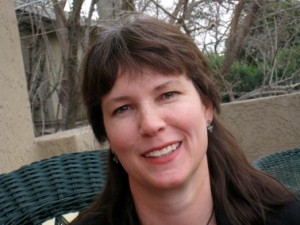 Emily Talen, a senior sustainability scientist and professor in ASU’s School of Geographical Sciences and Urban Planning, has been chosen for one of this year’s prestigious Guggenheim Fellowships. The fellowship program selected 178 scholars, artists and scientists from among almost 3,000 applicants on the basis of prior achievement and exceptional promise.
Emily Talen, a senior sustainability scientist and professor in ASU’s School of Geographical Sciences and Urban Planning, has been chosen for one of this year’s prestigious Guggenheim Fellowships. The fellowship program selected 178 scholars, artists and scientists from among almost 3,000 applicants on the basis of prior achievement and exceptional promise.
Talen, who holds the fellowship from July 2014 through June 2015, intends to use it to compose a book about neighborhoods. The book, to be published by the University of Chicago Press, will compare neighborhoods throughout time and in places with varying cultures. With over 2,000 sources on the topic already, Talen aims to determine what urban form means for social interactivity – for example, do certain city patterns create a “sense of community”?
“The book is ‘all things neighborhood.' I’ll explore how they’re idealized, abstracted, attributed effects, designed, bounded, fought over," Talen explains. "My task is to try to make sense of it all, tease out the big picture and think about what neighborhoods have to do with the future sustainable city."
View Source | April 16, 2014
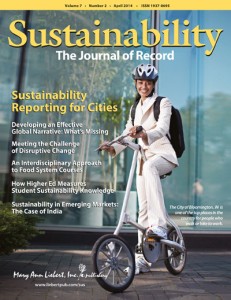 In the April 2014 issue of Sustainability: The Journal of Record, Senior Sustainability Scientist and School of Sustainability Professor of Practice George Basile and co-author Scott McNall expound on the necessity for a new sustainability narrative in their second installment on the subject.
In the April 2014 issue of Sustainability: The Journal of Record, Senior Sustainability Scientist and School of Sustainability Professor of Practice George Basile and co-author Scott McNall expound on the necessity for a new sustainability narrative in their second installment on the subject.
In their article, “How to Create a New Narrative for Sustainability That Will Work: And Why It Matters, Part 2,” McNall and Basile draw from social movement theory to illustrate how humans make decisions. They demonstrate that successful movements of the past share several key characteristics, such as a well-defined grievance and a solution that can be achieved. Though the sustainability movement possesses these characteristics, it must do a better job of of aligning its goals with those of its members.
As McNall and Basile conclude, "[The sustainability movement] must be about common values and common needs; it must be framed so that we understand that it is our responsibility to act now! A sustainability narrative will embrace the idea that the problems we face are practical ones, solvable through leadership and innovation at the local as well as the global level."
View Source | April 14, 2014
 The United States and China, two of the world’s biggest electronic waste (e-waste) producers, have joined forces to promote the prevention of e-waste through the U.S.-China Green Electronics Competition. Spearheaded by the Future Tense initiative - a partnership of Arizona State University, New America Foundation and Slate magazine - and China's Tsinghua University, the competition invites participants to repurpose yesterday's electronics by using them to repair an existing product, develop a new product or create artwork.
The United States and China, two of the world’s biggest electronic waste (e-waste) producers, have joined forces to promote the prevention of e-waste through the U.S.-China Green Electronics Competition. Spearheaded by the Future Tense initiative - a partnership of Arizona State University, New America Foundation and Slate magazine - and China's Tsinghua University, the competition invites participants to repurpose yesterday's electronics by using them to repair an existing product, develop a new product or create artwork.
With rapid advances in technology, electronics tend to become obsolete after just a few years. Though approximately 50 million tons of this electronic waste is produced each year, only about 15 to 20 percent is recycled, a cause for significant concern for both human and environmental health. Walton Sustainability Solutions Initiatives Director Patricia Reiter said, “Supporting the sustainable efforts of preventing e-waste on the international level represents a tremendous opportunity for inspiring innovation and cultural exchange.”
View Source | April 13, 2014
 In a salute to the community spirit that drives local and global progress, soccer, sunshine and sustainability converged for the first bi-continental, co-ed Earth Day Soccer Classic soccer tournament on April 12. As community soccer teams took to the intramural fields near the Sun Devil Fitness Complex on Arizona State University’s Tempe campus, schoolchildren in the African city of Accra, Ghana played on a field lit by solar technology.
In a salute to the community spirit that drives local and global progress, soccer, sunshine and sustainability converged for the first bi-continental, co-ed Earth Day Soccer Classic soccer tournament on April 12. As community soccer teams took to the intramural fields near the Sun Devil Fitness Complex on Arizona State University’s Tempe campus, schoolchildren in the African city of Accra, Ghana played on a field lit by solar technology.
An Earth Day Celebration and Expo – with green-themed, family-friendly activities and entertainment – accompanied the soccer tournament, which showcased the One World Futbol. This innovative, nearly indestructible soccer ball never needs a pump and never goes flat – even when punctured. The tournament balls were donated to the Tempe Boys & Girls Club, while tournament proceeds provided soccer clubs in Accra, Ghana with this ultra-sustainable product.
April 11, 2014
Dave White, Mike Lacey, Ron Raynor, and Brian Betcher discuss the issue of water usage in agriculture, which uses two-thirds of Arizona's water demand.
Central Arizona has a rich history of agriculture, contributing $9.2 billion toward the state’s economy. That water has near-absolute power in determining the region’s fate is not an over-reaching assumption. With increasing urban development and uncertain climate, is this industry doomed or can it be sustained?
Dave White, co-director of DCDC
Mike Lacey, director, Arizona Department of Water Resources
Ron Raynor, Owner, A Tumbling-T Ranches in Goodyear
Brian M. Betcher, Maricopa Stanfield Irrigation and Drainage District
Watch the video created by ASU Video Production.
View Source | April 10, 2014
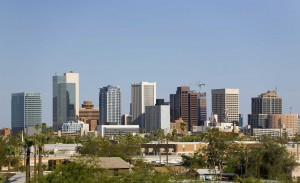 STAR Communities and Arizona State University’s Sustainability Solutions Services have announced a partnership to support local governments that are interested in benchmarking and tracking their sustainability performance. The partnership benefits STAR Community Rating System applicants in that universities are able to facilitate the data collection and reporting necessary for certification, which requires demonstration of sustainability across economic, environmental and social sectors.
STAR Communities and Arizona State University’s Sustainability Solutions Services have announced a partnership to support local governments that are interested in benchmarking and tracking their sustainability performance. The partnership benefits STAR Community Rating System applicants in that universities are able to facilitate the data collection and reporting necessary for certification, which requires demonstration of sustainability across economic, environmental and social sectors.
“STAR allows the ASU Solutions Services group to help communities conceptualize how their current activities fit into a larger sustainability framework, as well as plan, prioritize and measure progress toward their goals,” said Mick Dalrymple, practice lead for Sustainability Solutions Services. “By becoming a University STAR Affiliate, we can better share, promote, implement and extend solutions that address sustainable approaches to complex community challenges at both a local and global scale."
View Source | April 10, 2014
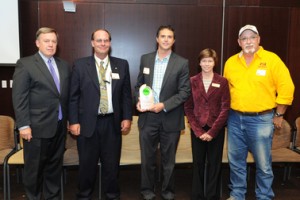 In recognition of the achievements of ASU faculty and staff, ASU President Michael M. Crow presented awards at an April 2 ceremony in the areas of innovation, social embeddedness and sustainability. The President's Award for Sustainability recognizes ASU teams that have demonstrated excellence in fostering the successful development, implementation and promotion of sustainability principles, solutions, programs and services in the teaching, learning, research and business missions of the university.
In recognition of the achievements of ASU faculty and staff, ASU President Michael M. Crow presented awards at an April 2 ceremony in the areas of innovation, social embeddedness and sustainability. The President's Award for Sustainability recognizes ASU teams that have demonstrated excellence in fostering the successful development, implementation and promotion of sustainability principles, solutions, programs and services in the teaching, learning, research and business missions of the university.
Of the four teams recognized in the area of sustainability, two featured members of the Wrigley Sustainability Institute. ASU Green Labs, a program implemented by Environmental Health and Safety (EH&S), promotes enhanced awareness of sustainability in university laboratories in an effort to decrease ASU’s overall carbon footprint. The Salt River Waste Diversion Program, a partnership between Salt River Project (SRP) and Sustainability Solutions Services (S3) of the Walton Sustainability Solutions Initiatives, seeks to maximize SRP's waste diversion potential while increasing the amount of materials recycled and reducing the environmental impact caused by its landfill.
View Source | April 9, 2014
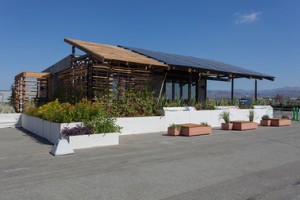 Twenty-three current and former ASU students from various departments – including the School of Sustainability – were part of the ASUNM team that produced a structure called SHADE (Solar Homes Adapting for Desert Equilibrium). SHADE, which uses building materials and energy systems that are particularly effective and sustainable in a Southwestern desert environment, won fifth place in the architecture category and sixth in the engineering category of the 2013 Solar Decathlon. After making appearances in several states, it has returned to Phoenix and will soon be open for tours.
Twenty-three current and former ASU students from various departments – including the School of Sustainability – were part of the ASUNM team that produced a structure called SHADE (Solar Homes Adapting for Desert Equilibrium). SHADE, which uses building materials and energy systems that are particularly effective and sustainable in a Southwestern desert environment, won fifth place in the architecture category and sixth in the engineering category of the 2013 Solar Decathlon. After making appearances in several states, it has returned to Phoenix and will soon be open for tours.
The Solar Decathlon, sponsored by the U.S. Department of Energy, challenges teams to design and build innovative, affordable, sturdily crafted and comfortable solar-powered houses that produce as much energy as they consume and incorporate other sustainable living features. Students from ASU and University of New Mexico joined forces to form one of 19 teams of college students throughout the world selected to participate in the competition. The ASU students involved in the project hope it sparks further efforts to promote sustainable living.
View Source | April 9, 2014
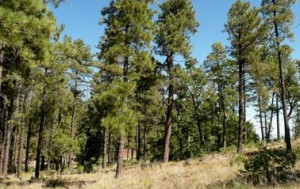 A report produced by Arizona State University’s Sustainability Solutions Services (S3) and The Nature Conservancy indicates that a thinning process could boost the health of Arizona’s forests while making them more resistant to environmental extremes and strengthening rural economies.The report, titled “Modeling the Economic Viability of Restorative Thinning,” provides an assessment of possible wood processors and consumers, or “business clusters,” if small diameter wood from northern Arizona was sustainably harvested.
A report produced by Arizona State University’s Sustainability Solutions Services (S3) and The Nature Conservancy indicates that a thinning process could boost the health of Arizona’s forests while making them more resistant to environmental extremes and strengthening rural economies.The report, titled “Modeling the Economic Viability of Restorative Thinning,” provides an assessment of possible wood processors and consumers, or “business clusters,” if small diameter wood from northern Arizona was sustainably harvested.
The services first surveyed existing businesses, reviewed current and emerging technologies, and toured forest thinning and small diameter wood product operations in Arizona. A generalized model of a forest product supply chain based on small diameter wood was used to investigate industry scenarios in a variety of forested landscapes. Should this practice be adopted, the anticipated benefits include a lessened risk of catastrophic fires, erosion and sedimentation of downstream reservoirs, as well as improved wildlife habitat, protected recreational opportunities and an increase in water for our rivers and communities.
View Source | April 8, 2014
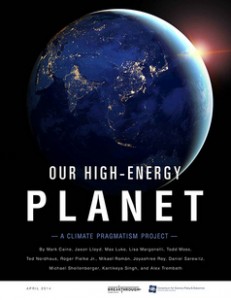 In a report called Our High-Energy Planet, co-authored by Senior Sustainability Scientists Daniel Sarewitz and Netra Chhetri, scholars say that giving the poor access to reliable modern energy offers a promising route to addressing global challenges like climate change. Given the pivotal relationship between abundant energy access and human development, climate change must be addressed within the context of poor nations gaining access to modern energy.
In a report called Our High-Energy Planet, co-authored by Senior Sustainability Scientists Daniel Sarewitz and Netra Chhetri, scholars say that giving the poor access to reliable modern energy offers a promising route to addressing global challenges like climate change. Given the pivotal relationship between abundant energy access and human development, climate change must be addressed within the context of poor nations gaining access to modern energy.
Emphasizing that innovation is the key to reducing emissions while expanding energy access, the report points out that power sectors are growing at breakneck speeds in emerging nations and that their development creates tremendous opportunities. The report is the first of the Climate Pragmatism project, led by Arizona State University’s Consortium for Science, Policy, and Outcomes in partnership with The Breakthrough Institute.
View Source | April 8, 2014
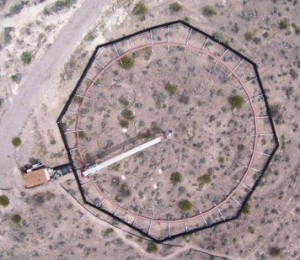 A national team of researchers, including Arizona State University Senior Sustainability Scientist Kiona Ogle, has discovered that arid lands, among the most expansive ecosystems on the planet, absorb an unexpectedly large amount of carbon otherwise released into the atmosphere. Ogle, an expert with extensive knowledge of both complex datasets and desert ecology, assisted in interpreting the findings.
A national team of researchers, including Arizona State University Senior Sustainability Scientist Kiona Ogle, has discovered that arid lands, among the most expansive ecosystems on the planet, absorb an unexpectedly large amount of carbon otherwise released into the atmosphere. Ogle, an expert with extensive knowledge of both complex datasets and desert ecology, assisted in interpreting the findings.
The study, published in the journal Nature Climate Change, comes after a novel 10-year experiment in which researchers exposed plots in the Mojave Desert to elevated carbon-dioxide levels similar to those expected in 2050. The researchers then removed soil and plants down to a meter deep and measured how much carbon was absorbed. These findings give scientists a better handle on the earth’s carbon budget, as well as help to explain the degree to which land-based ecosystems absorb or release carbon dioxide as it increases in the atmosphere.
View Source | April 7, 2014
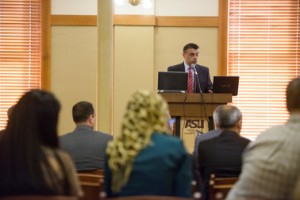 Representatives from Arizona and Palestine spanned the geographical gap to meet March 24-28 at Arizona State University's Tempe campus for the Renewable Energy Leadership Training Program. Though thousands of miles apart, the two nations face similar energy challenges - including transmission, funding and technology - making this partnership an ideal opportunity to share struggles and successes.
Representatives from Arizona and Palestine spanned the geographical gap to meet March 24-28 at Arizona State University's Tempe campus for the Renewable Energy Leadership Training Program. Though thousands of miles apart, the two nations face similar energy challenges - including transmission, funding and technology - making this partnership an ideal opportunity to share struggles and successes.
Throughout the course of the Renewable Energy Leadership Training Program, attendees developed roadmaps toward a sustainable and independent energy system. Additionally, they had the opportunity to tour local facilities like First Solar, the ASU Solar Power Lab, TÜV Rheinland and the Arizona Center for Algae Technology and Innovation on ASU's Polytechnic campus. Following the program, they will seek to implement their renewable energy projects in Palestine.
The university plans to expand the program in order to provide continued support for energy transformation in both the United States and developing nations.
View Source | April 3, 2014
School of Sustainability student Kevin Keleher is named Changemaker Entrepreneur of the Year at the 2014 Pitchfork Awards. GreenLight Solutions, the sustainability consulting service Keleher co-founded with four other students, is named the Most Promising Student Organization.
View Source | April 2, 2014
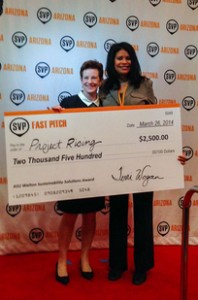 Leslie Lindo, co-founder and executive director of Project Rising, was presented with the 2014 Walton Sustainability Solutions Award at Social Venture Partners of Arizona's "Fast Pitch" competition. The award, given by Arizona State University’s Sustainability Solutions Festival, recognizes Lindo's vision to foster a stronger, healthier community by reactivating the vacant lots of Phoenix using sustainable building techniques.
Leslie Lindo, co-founder and executive director of Project Rising, was presented with the 2014 Walton Sustainability Solutions Award at Social Venture Partners of Arizona's "Fast Pitch" competition. The award, given by Arizona State University’s Sustainability Solutions Festival, recognizes Lindo's vision to foster a stronger, healthier community by reactivating the vacant lots of Phoenix using sustainable building techniques.
"The businesses Project Rising engenders from the community offer long-term employment in Arizona, safe lighting for neighborhoods, community gathering places and social connectivity," said Kelly Saunders, a "Fast Pitch" judge and project coordinator of the Sustainability Solutions Festival. "Project Rising understands that it is more sustainable and successful to create a community with the community."
View Source | April 1, 2014
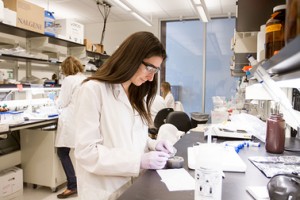 The U.S. Environmental Protection Agency (EPA) has awarded a grant of $5 million over the next four years to support the LCnano Network as part of the Life Cycle of Nanomaterials project. The focus of the project, which is led by LCnano Network Director and Senior Sustainability Scientist Paul Westerhoff, is to help ensure the safety of nanomaterials throughout their life cycles – from manufacture to use and disposal.
The U.S. Environmental Protection Agency (EPA) has awarded a grant of $5 million over the next four years to support the LCnano Network as part of the Life Cycle of Nanomaterials project. The focus of the project, which is led by LCnano Network Director and Senior Sustainability Scientist Paul Westerhoff, is to help ensure the safety of nanomaterials throughout their life cycles – from manufacture to use and disposal.
Nanoparticles, which are approximately 1 to 100 nanometers in size, are used in an increasing number of consumer products to provide texture, resiliency and, in some cases, antibacterial protection. Westerhoff says there remains “a big knowledge gap” about how, or if, nanomaterials are released from consumer products into the environment as they move through their life cycles, eventually ending up in soils and water systems. The multi-university team of engineers, chemists, toxicologists and social scientists will collaborate with industry and government laboratories to find ways of reducing such uncertainties.
View Source | April 1, 2014
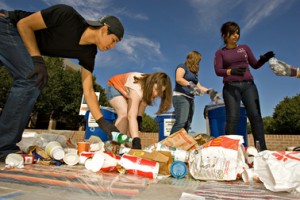 On April 1, Arizona State University launched the university-wide Zero Waste at ASU initiative to kick off Earth Month 2014. The zero waste principle aims for the diversion and aversion of more than 90 percent of trash from the landfill. Diversion techniques include blue bin recycling, green bin composting and reusing or repurposing; and aversion tactics include reducing or avoiding the use of non-recyclable and non-compostable materials altogether. The initiative hopes to help ASU achieve zero solid waste by 2015.
On April 1, Arizona State University launched the university-wide Zero Waste at ASU initiative to kick off Earth Month 2014. The zero waste principle aims for the diversion and aversion of more than 90 percent of trash from the landfill. Diversion techniques include blue bin recycling, green bin composting and reusing or repurposing; and aversion tactics include reducing or avoiding the use of non-recyclable and non-compostable materials altogether. The initiative hopes to help ASU achieve zero solid waste by 2015.
"As a New American University, ASU is committed to catalyzing social change and enabling students to succeed by being at the cutting edge of a healthy, sustainable learning environment," said ASU President Michael M. Crow. "By aiming to become a zero-waste university, ASU is not only making progress toward its goal of cutting greenhouse gas emissions and becoming climate neutral, but also instilling sustainability as a value in our students, staff and faculty, who form the critical mass to significantly impact the institution, as well as their communities."
March 31, 2014
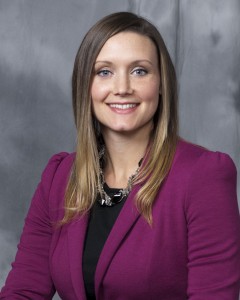 Now working to bring a renewable surface water supply from the Colorado River to Central Arizona, alum Jessica Fox has a long-standing interest in sustainability.
Now working to bring a renewable surface water supply from the Colorado River to Central Arizona, alum Jessica Fox has a long-standing interest in sustainability.
As a high school student in in Canandaigua, New York, Jessica was fascinated by the intersection between environmental science and economics. Wanting to learn more, she enrolled in State University of New York’s College of Environmental Science and Forestry. Several years after graduating with a bachelor’s in environmental science and policy, along with a minor in management science from Syracuse University, she decided to pursue a graduate education in water policy.
“Water is obviously much more plentiful in the Northeast, and it’s governed differently there, so I wanted to study how water is allocated and managed under scarce conditions in the Western US,” Jessica says.
March 31, 2014
By Christopher Vaughan for ASU Magazine. March 2014.
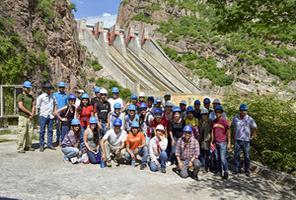 When ASU professor Enrique Vivoni brings American students across the border to Mexico, it’s an eye-opener for them. As part of the US/Mexico Border Water and Environmental Sustainability Training Program, Vivoni works regularly with American and Mexican students on both sides of the border to help them gain a deeper understanding of the water scarcity problems in the Arizona-Sonora desert region. When the students see the many water problems that Phoenix has solved but Mexico is still working on, the common reaction is "I didn’t realize we had it so good," Vivoni says.
When ASU professor Enrique Vivoni brings American students across the border to Mexico, it’s an eye-opener for them. As part of the US/Mexico Border Water and Environmental Sustainability Training Program, Vivoni works regularly with American and Mexican students on both sides of the border to help them gain a deeper understanding of the water scarcity problems in the Arizona-Sonora desert region. When the students see the many water problems that Phoenix has solved but Mexico is still working on, the common reaction is "I didn’t realize we had it so good," Vivoni says.
Over the last century, Arizona has created hydrological solutions that have allowed us to populate the desert and made access to water a "soft" problem that most people don’t need to think about, Vivoni says. But that is changing. The needs of agriculture and growing populations will more than drain existing water sources in the state. Historical weather cycles and a changing climate will likely make water supplies even more uncertain. And as hard as things get in the United States, the challenges that populations around the world face in securing adequate water supplies only will grow more dire. Some say that eventually water will be more expensive than oil.
ASU finds itself in a unique position, blessed with the position and resources to address the huge challenges surrounding water access, not only for local communities, but also for cities around the world. Accessing expertise in hydrology, the life sciences, geography, engineering, design and law, ASU researchers are tackling the multifaceted issues involved in solving the problem of water security.
"ASU is well positioned geographically for dealing with many of these problems, and we are leveraging our place along the United States-Mexico border region to understand water issues through many of our faculty members," Vivoni says.
Professor John Sabo is one of those faculty members studying the problem. As director of research development and senior sustainability scientist at the Global Institute of Sustainability, Sabo knows that communities shouldn’t use more than 40 percent of the renewable water supply to ensure sustainability. "In the region [of the Southwestern United States] known as the ‘Cadillac Desert’ the water use is close to almost 80 percent of the renewable supply," Sabo says. "We are never going to get to 40 percent; we could get to 60 percent, but it would be costly."
Just exactly how costly?
"If you cost it out, it’s somewhere between $4.5 billion and $8 billion annually over the next 6-14 years across all seven basin states," Sabo says. Included in that calculation is an assumption that cities and farms will each become 20 percent more efficient than they are now. "That is not trivial — it works out to between $250 and $875 dollars per year per household," he notes.
One focus of Sabo’s research is on what amount of water is needed to sustain the natural environment, which is often the neglected third element of the water discussion.
Sabo and his colleagues use the different isotopic profiles of river and groundwater to trace the source of the water on which plants and animals along the river depend for survival. His work has shown the surprising result that it is groundwater, not the surface water that comes down the river, that is providing most of the water for the flora and fauna that exists at the river’s edge.
"It’s said that water always flows toward money, and in the struggle for water between cities and agriculture, the environment always loses out," he says.
Since water flows toward money, Sabo argues that the only way to protect the river environment is to create new legal and fiscal structures that can protect water for that environment.
"My recent paper is about financing reform that would protect that environment," he says. He goes on to say that either people will have to rewrite the compact that governs Colorado river water, for instance, or they will have to work within the existing compact to provide the money that buys those water rights and places them in trusts where they are preserved for ecosystems.
"Rewriting compacts is not an option here; trusts are much more tractable," he says.
Balancing the needs of agriculture, cities and the environment will come only from making many such difficult decisions, and each decision will have many "downstream" effects on other human activities. Getting decisions makers the best possible information about water use and future scenarios has been a major reason for creating the Decision Center for a Desert City (DCDC) in the Global Institute of Sustainability.
Patricia Gober, the founding director of the center and a professor in the School of Geographical Sciences and Urban Planning and in the School of Sustainability, was one of those who decided to use the Phoenix area as a case study of how to help people make better decisions about water management. The effort draws from a wide variety of disciplines. There are currently more than 20 faculty co-investigators from the social, behavioral and physical sciences in addition to hydrology and climatology.
"We created a computerized water simulation model that looked at supply and demand for Central Arizona, community by community," Gober says. "We made it interactive through the use of slider bars to change levels of population growth and indoor and outdoor water use."
They exposed elected officials and water managers to the model in the Decision Theater, an immersive audio/visual environment, and worked through various scenarios with them to understand how officials balance needs and make decisions. "We also study ourselves," Gober says. "We tried to learn how scientists engage with decision makers and how we can improve that interaction."
The simulation continues to be refined. "We are on WaterSim 5.0 now — it will never be finished," she said.
The reins of DCDC now have been taken up by Associate Professor Dave White, the current co-director of the center and its principal investigator. "ASU is producing science and knowledge that is not only the best available, but also because of the close collaboration with the decision-making community, it has relevance and salience" in the world at large, White says.
Of most concern to him now in Arizona are the combination of the state’s growing population and the natural variability of the weather, including cyclical dry periods that can last 30 years, plus the uncertain pressures brought on by climate change.
"On top of that, we could have a catastrophic wildfire in the mountains that prevents the accumulation of the snowpack that usually releases water into summer," said White, who is also a senior sustainability scientist at ASU’s Global Institute of Sustainability. "That scenario is really problematic for me now."
A key element of the center and its programs is that knowledge flows both ways.
"We learn a lot from the managers of those agencies," White says. "That knowledge leads to enhanced science on our side."
Mutual understanding and close cooperation will become vastly more important in the future, White says. Like most researchers working on water projects at ASU, White says he is both pragmatic and realistic about the water challenges we face. Ultimately, the researchers tend to believe that smart research and thoughtful decision-making will head off the worst scenarios and ensure that communities don’t go dry.
"I’m optimistic about our ability to deal with these things," White says.
Author Christopher Vaughan is a freelance science writer based in Menlo Park, CA
View Source | March 31, 2014
 Senior Sustainability Scientist Netra Chhetri is cited in a Christian Science Monitor article summarizing a report released by the Intergovernmental Panel on Climate Change (IPCC). In the article, Chhetri - who contirbuted to the report's chapter on food security - emphasizes the importance of recognizing the non-climate-related effects of global warming when working toward resilience.
Senior Sustainability Scientist Netra Chhetri is cited in a Christian Science Monitor article summarizing a report released by the Intergovernmental Panel on Climate Change (IPCC). In the article, Chhetri - who contirbuted to the report's chapter on food security - emphasizes the importance of recognizing the non-climate-related effects of global warming when working toward resilience.